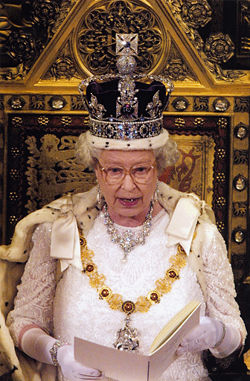Monarchy of the United Kingdom: Difference between revisions
imported>John Stephenson (start) |
imported>John Stephenson (Update on succession) |
||
| Line 1: | Line 1: | ||
{{subpages}} | {{subpages}} | ||
{{Image|Liz2-state-opening-parliament-speech.jpg|right|250px|The [[monarch]] visits [[Parliament of the United Kingdom|Parliament]] annually in a ceremony to begin parliamentary proceedings. During this State Opening of Parliament, the Queen's Speech sets out her [[Government of the United Kingdom|government]]'s intentions for the coming year.}} | {{Image|Liz2-state-opening-parliament-speech.jpg|right|250px|The [[monarch]] visits [[Parliament of the United Kingdom|Parliament]] annually in a ceremony to begin parliamentary proceedings. During this State Opening of Parliament, the Queen's Speech sets out her [[Government of the United Kingdom|government]]'s intentions for the coming year.}} | ||
The [[monarchy]] in the [[United Kingdom]] and its [[British Overseas Territories|territories]] is an institution which provides the British [[head of state]] as a [[king]] or [[queen]] with ceremonial powers. The [[government of the United Kingdom]] runs the country in the name of the monarch. The monarchy is therefore a [[constitutional monarchy]], having no real [[politics|political]] power, but the Royal Family performs a variety of duties | The [[monarchy]] in the [[United Kingdom]] and its [[British Overseas Territories|territories]] is an institution which provides the British [[head of state]] as a [[king]] or [[queen]] with ceremonial powers. The [[government of the United Kingdom]] runs the country in the name of the monarch. The monarchy is therefore a [[constitutional monarchy]], having no real [[politics|political]] power, but the Royal Family performs a variety of duties. Since 1952 the head of [[state]] has been [[Elizabeth II]], one of the longest-reigning monarchs in world history. She is also Queen of [[Australia]], [[New Zealand]], [[Canada]] and 13 other sovereign nations, as well as being head of the [[Commonwealth of Nations]] and the [[Church of England]]. | ||
The British monarchy is hereditary, in that the eldest son or daughter of the monarch usually becomes King or Queen. Until 2011, when the law of succession was changed, a daughter would only become Queen if she had no brothers.<ref>''BBC News'': '[http://www.bbc.co.uk/news/uk-15492607 UK royal succession laws changed]'. 28th October 2011.</ref> The current [[heir]] to the throne is [[Charles, Prince of Wales]]. | |||
==Footnotes== | |||
{{reflist|2}} | |||
Revision as of 04:52, 28 October 2011

The monarch visits Parliament annually in a ceremony to begin parliamentary proceedings. During this State Opening of Parliament, the Queen's Speech sets out her government's intentions for the coming year.
The monarchy in the United Kingdom and its territories is an institution which provides the British head of state as a king or queen with ceremonial powers. The government of the United Kingdom runs the country in the name of the monarch. The monarchy is therefore a constitutional monarchy, having no real political power, but the Royal Family performs a variety of duties. Since 1952 the head of state has been Elizabeth II, one of the longest-reigning monarchs in world history. She is also Queen of Australia, New Zealand, Canada and 13 other sovereign nations, as well as being head of the Commonwealth of Nations and the Church of England.
The British monarchy is hereditary, in that the eldest son or daughter of the monarch usually becomes King or Queen. Until 2011, when the law of succession was changed, a daughter would only become Queen if she had no brothers.[1] The current heir to the throne is Charles, Prince of Wales.
Footnotes
- ↑ BBC News: 'UK royal succession laws changed'. 28th October 2011.